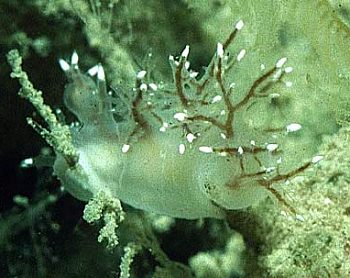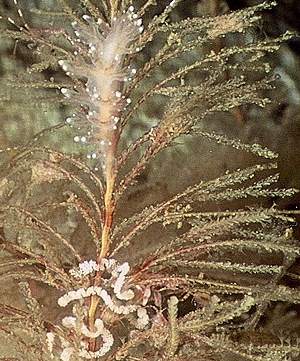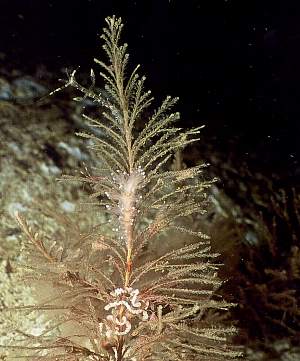
Dendronotus sp. 2
Order: NUDIBRANCHIA
Suborder: DENDRONOTINA
Family: Dendronotidae
DISTRIBUTION
North Atlantic [east and west coasts?]
PHOTO
Killary Harbour, Co. Galway, Ireland. - size 8mm on Sertularia argentea. April 1982. Photo: B.E.Picton.
See Bernard Picton's message.
Authorship detailsRudman, W.B., 2002 (September 19) Dendronotus sp. 2 [In] Sea Slug Forum. Australian Museum, Sydney. Available from http://www.seaslugforum.net/find/dendronsp2
Related messages
Re: Cuthona? from Nova Scotia
September 24, 2002
From: Bernard Picton

Hi Bill,
I'm fairly sure Alan's animal is Dendronotus perhaps (?frondosus). Now I'm sure you'll go - where are the branched processes? Look carefully at the 'cerata' - I think they are slightly branched. I'm not sure if these small ones are really D. frondosus at all, as they do seem to spawn at this size - see the eggs below in Alan's photo. It might be that they are a distinct species. I'm not sure if the hydroid is Sertularia argentea, but if it is, then that is what I've found these small grey Dendronotus on here in the UK.
I have looked out a photo of this odd Dendronotus from Ireland to accompany my message. April 1982 - Killary Harbour, Co. Galway, Ireland. - size 8mm. Photo: B. E. Picton.
Bernard
bernard.picton.um@nics.gov.uk
Picton, B. , 2002 (Sep 24) Re: Cuthona? from Nova Scotia. [Message in] Sea Slug Forum. Australian Museum, Sydney. Available from http://www.seaslugforum.net/find/7824Thanks Bernard,
An interesting suggestion. Perhaps Alan has a photo showing the 'cerata' more clearly.
Cheers,
Bill Rudman
Cuthona? from Nova Scotia
August 16, 2002
From: Alan Shepard


Dear Bill -
I've attached a photo I recently took while diving an artificial reef, the HMCS Saguenay off Lunenburg, Nova Scotia. It is one I have not encountered before.
I believe it a species of Cuthona but I'm not sure which. I went through Bernard Picton's web site, Nudibranchs of the British Isles but couldn't come up with a 100% positive ID. By the way I just ordered the Picton book to further assist me in my pursuit of northern Atlantic nudibranchs.
The nudibranch in question was found at a depth of approximately 20m. It was approximately 6mm long or so. The area it was found in does get strong currents. On the site itself I found approximately 9 species of nudibranchs. Most I had seen and photographed before. The other new find for me was Doto coronata. Unfortunately the photo of that nudibranch did not turn out well.
Regards,
Alan Shepard
alan.chepard@snet.net
Dear Alan,
I suspect this is probably Facelina bostoniensis but without a better idea of the rhinophores and body colour pattern that is a bit of a guess. Flabellina nobilis has white-tipped cerata like this, but the cerata in that species are more crowded along mantle edge. Hopefully Bernard or some other local expert can help us out. Is that a caprellid amphipod on the top left of the hydroid colony? I usually give up looking for aeolids if they are on a colony, they don't seem to be able to co-exist.
Cheers,
Bill Rudman
